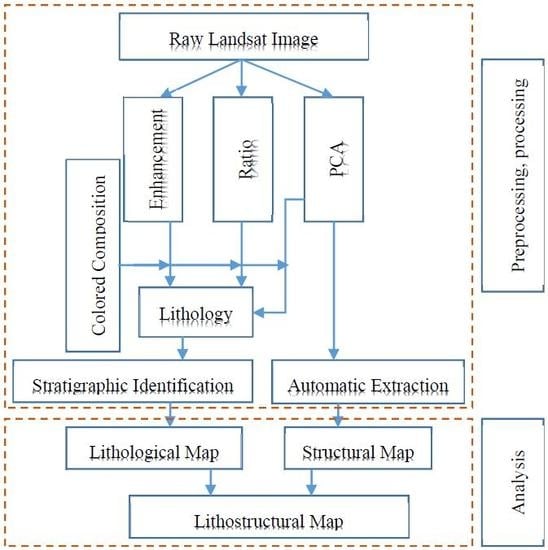Spatial Analysis of Linear Structures in the Exploration of Groundwater
Abstract
:1. Introduction
2. Data and Study Area
3. Methodology
4. Results
4.1. Lithological Mapping
4.2. Structural Mapping
4.3. Characterization of the Aquifers
4.3.1. Study of the Intensity of Linear Structures
4.3.2. Statistical Analysis of Linear Structures
4.3.3. Systems of Aquifers
- Crack-type aquifers are semi-continuous or discontinuous, depending on the density, extension, and degree of interconnection of cracking networks, which affect the host rock and its hydraulic relationship with surface layers in the overlay [24,25]. Cracked aquifers are represented by crystalline and sedimentary formations of the Precambrian.
- Generalized aquifers are associated with low or unconsolidated formations with intergranular porosities, mainly consisting of deposits of continental origin, accumulated in large sedimentary basins from the Secondary to the quaternary.
- These deep aquifer systems are covered by superficial aquifers located in lateritic alteration formations on the surface of plateaus or in the alluvial and colluvial deposits of the plains and valley bottoms. Depending on the thickness of the upper layer, and the local geomorphological and rainfall conditions, these superficial aquifers can be semi-continuous and in hydraulic connection with deep or discontinuous aquifers.
5. Discussion
6. Conclusions
Acknowledgments
Author Contributions
Conflicts of Interest
References
- Bodin, J.; Razack, M. Image analysis applied to the automatic treatment of fracture fields, “L’analyse d’images appliquée au traitement automatique de champs de fractures. Propriétés géométriques et lois d’échelle” (Geometric properties and laws of scale). Bull. Soc. Géol. Fr. 1999, 170, 579–593. [Google Scholar]
- Xue, C.; Fan, X.; Dong, Q.; Liu, J. Using remote sensing products to identify marine association patterns in factors relating to ENSO in the Pacific Ocean. ISPRS Int. J. Geo-Inf. 2017, 6, 32. [Google Scholar] [CrossRef]
- Koudou, A.; Assoma, T.V.; Adiaffi, B.; Ta Youan, M.; Kouame, K.F.; Lasm, T. Analyses Statistique Et Geostatistique De La Fracturation Extraite De L’Imagerie Asar Envisat Du Sud-Est De La Côte D‘ Ivoire’. LARHYSS J. 2014, 20, 147–166. [Google Scholar]
- Tziachris, P.; Metaxa, E.; Papadopoulos, F.; Papadopoulou, M. Spatial Modelling and Prediction Assessment of Soil Iron Using Kriging Interpolation with pH as Auxiliary Information. ISPRS Int. J. Geo-Inf. 2017, 6, 283. [Google Scholar] [CrossRef]
- Gbele, O.; Gnammytchet, B.K.; Bertin, D.Y. The Remote Sensing Imagery, New Challenges For Geological And Mining Mapping In The West African Craton - The Example The First Steps of Remote Sensing Imagery for Geological and Mining Mapping. Int. J. Geogr. Geol. 2013, 1, 1–13. (In French) [Google Scholar]
- Olivry, J.; Bricquet, J.P.; Mahe, G. Variabilité de la puissance des crues des grands cours d’eau d’Afrique intertropicale et incidence de la baisse des écoulements de base au cours des deux dernières décennies. In Proceedings of the Abidjan’98 Conference, Abidjan, Côte d’lvoire, November 1998. [Google Scholar]
- Zare, A.; Illou, M.; Fossi, S.; Bio, T.M.; Mahe, G.; Paturel, J.E.; Barbier, B. Perception of hydrological changes and adaptation strategies in the Inner Niger Delta in Mali. In Proceedings of the HP1, IAHS-IAPSO-IASPEI Assembly, Gothenburg, Sweden, 22–26 July 2013; Volume 358, pp. 129–130. [Google Scholar]
- Taubenböck, H.; Ferstl, J.; Dech, S. Regions Set in Stone—Delimiting and Categorizing Regions in Europe by Settlement Patterns Derived from EO-Data. ISPRS Int. J. Geo-Inf. 2017, 6, 55. [Google Scholar] [CrossRef]
- Mwaniki, M.W.; Moeller, M.S.; Schellmann, G.; Hue, I. A comparison of Landsat 8 (OLI) and Landsat 7 (ETM +) in mapping geology and visualising linear structures: A case study of central region Kenya. Int. Arch. Photogramm. Remote Sens. Spat. Inf. Sci. 2015, XL, 11–15. [Google Scholar]
- Rimal, B.; Zhang, L.; Keshtkar, H.; Wang, N.; Lin, Y. Monitoring and Modeling of Spatiotemporal Urban Expansion and Land-Use/Land-Cover Change Using Integrated Markov Chain Cellular Automata Model. ISPRS Int. J. Geo-Inf. 2017, 6, 288. [Google Scholar] [CrossRef]
- Lucas, G. Investigating the Potential of Landsat 8 OLI Satellite Imagery for Geological Mapping in Namibia. In Proceedings of the Roy Miller Symposium, Windhoek, Namibia, 18–20 August 2014; p. 2005. [Google Scholar]
- Kwak, Y. Nationwide Flood Monitoring for Disaster Risk Reduction Using Multiple Satellite Data. ISPRS Int. J. Geo-Inf. 2017, 6, 203. [Google Scholar] [CrossRef]
- Censier, C.; Olivry, J.C.; Briquet, J.P. Les Apports Detritiques Terrigenes Dans la Cuvette Lacustre du Niger entre Mopti et Kona (Republique du Mali). In Proceedings of the Great Fluvial Basins, Paris, France, 22–24 November 1993; pp. 22–24. [Google Scholar]
- Thibault, M.; Mod, M. Modélisation hydrodynamique couplée 1D-2D du delta intérieur du fleuve Niger. 1D-2D Coupled Hydrodynamic Modeling of the Niger River Inland Delta. Master’s Thesis, Higher institute of Agronomic, Agri-Food, Horticultural and Landscape Sciences, Rennes, France, 2014; p. 41. [Google Scholar]
- Li, S.; Cui, Y.; Liu, M.; He, H.; Ravan, S. Integrating Global Open Geo-Information for Major Disaster Assessment: A Case Study of the Myanmar Flood. ISPRS Int. J. Geo-Inf. 2017, 6, 201. [Google Scholar] [CrossRef]
- PCI Geomatica. PCI Geomatica user’s Guide Version 9.1; PCI Geomatica: Richmond Hill, ON, Canada, 2001. [Google Scholar]
- Schowengerddt, R.A. Technics for Image Processing and Classification in Remote Sensing; Academic Press: New York, NY, USA, 1983. [Google Scholar]
- Madani, A. Assessment and Evaluation of Band Ratios, Brovey and HSV Techniques for Lithologic Discrimination and Mapping Using Landsat ETM + and SPOT-5 Data. Int. J. Geosci. 2014, 2014, 5–11. [Google Scholar] [CrossRef]
- Estornell, J.; Martí, J.M.; Sebastiá, T.; Mengual, J. Principal Component Analysis applied to remote sensing. Model. Sci. Educ. Learn. 2013, 6, 83–90. [Google Scholar] [CrossRef]
- Servat, É.; Paturel, J.E.; Lubès-Niel, H.; Kouamé, B.; Masson, J.M.; Travaglio, M.; Marieu, B. De différents aspects de la variabilité de la pluviométrie en Afrique de l’Ouest et Centrale non sahélienne. Rev. Sci. Eau/J. Water Sci. 1999, 12, 363–387. [Google Scholar] [CrossRef]
- Franchi, G.; Angulo, J. Morphological Principal Component Analysis for Hyperspectral Image Analysis †. ISPRS Int. J. Geo-Inf. 2016, 5, 83. [Google Scholar] [CrossRef]
- Aranyossy, J.-F.; Njitchoua, R.; Zuppi, G.M. Input of Environmental Isotopes in the Study of the Recharge and the Flow Dynamic of Aquifers; No. ST/pub/747; IAEA: Vienna, Austria, 1995; pp. 309–324. [Google Scholar]
- Picouet, C. Géodynamique d’un hydrosysteme tropical peu anthropisé, le bassin supérieur du Niger et son delta intérieur. Ph.D. Thesis, Université de Montpellier II, Montpellier, France, 1999; p. 470. [Google Scholar]
- Hydrosyst, G.I.P. “Projet de zone atelier du Delta intérieur du Niger au Mali,” (Inner Delta Workshop Project in Mali). In Proceedings of the Séminaire Franco-Malien du GIP Hydrosystèmes, Paris, France, April 1997; p. 42. [Google Scholar]
- Mahe, G.; Orange, D.; Mariko, A.; Bricquet, J.P. Estimation of the flooded area of the Inner Delta of the River Niger in Mali by hydrological balance and satellite data. In Hydro-climatology: Variability and Change; International Association of Hydrological Sciences (IAHS): Wallingford, UK, 2011; pp. 138–143. [Google Scholar]
- Randersen, I.; Dione, O.; Holder, M.J.; Olivry, J.C. Le Bassin du Fleuve Niger Vers une Vision de Développement Durable; World Bank: Washington, DC, USA, 2006; p. 172. [Google Scholar]
- Mariko, A.; Mahe, G.; Orange, D.; Royer, A.; Nonguierma, A.; Amani, A.; Servat, E. Suivi des Zones D’inondation du Delta Intérieur du Niger (Monitoring Flood Zones in the Niger’s Interior Delta); IRD: Bondy, France, 1999; pp. 231–244.
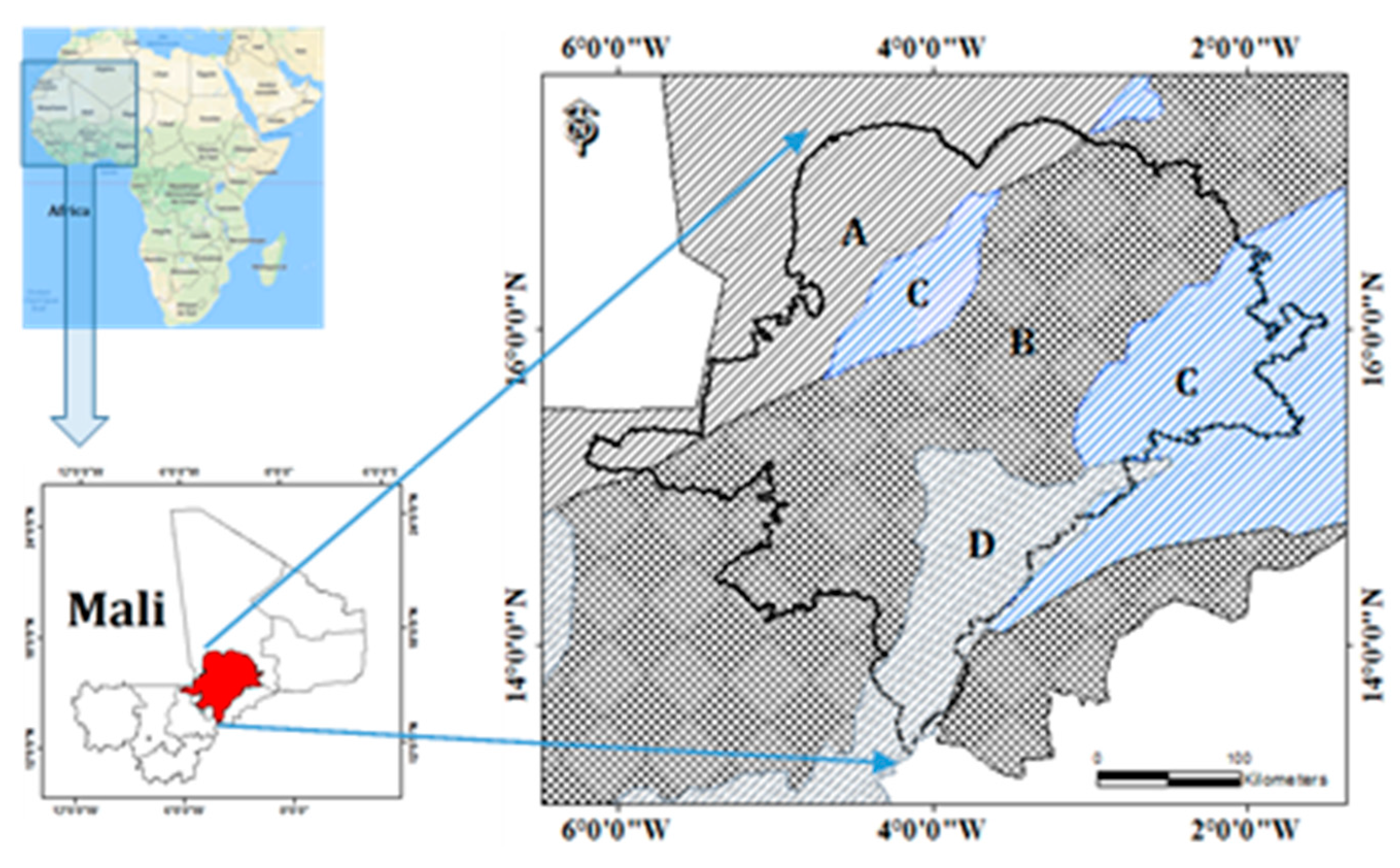
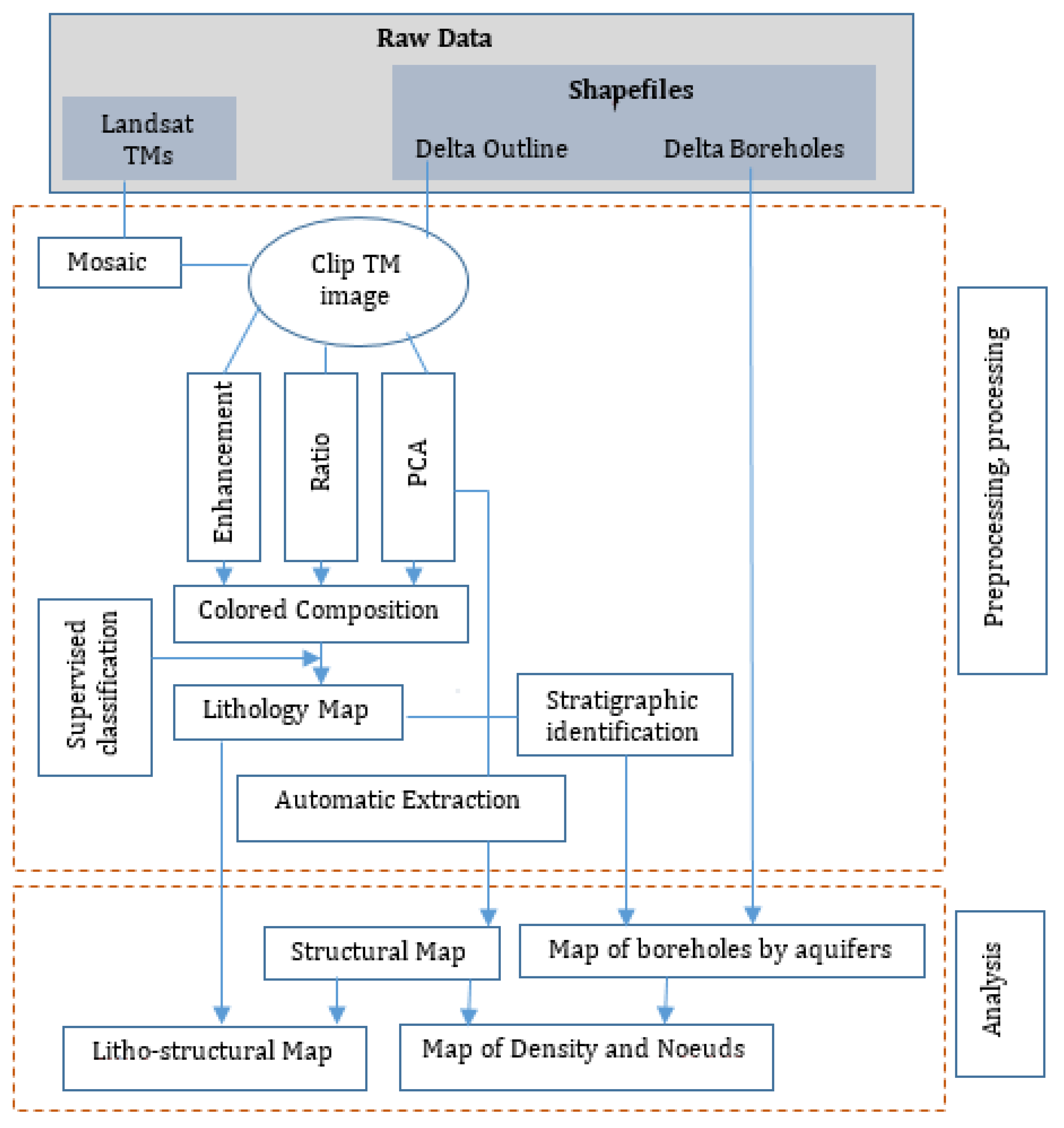

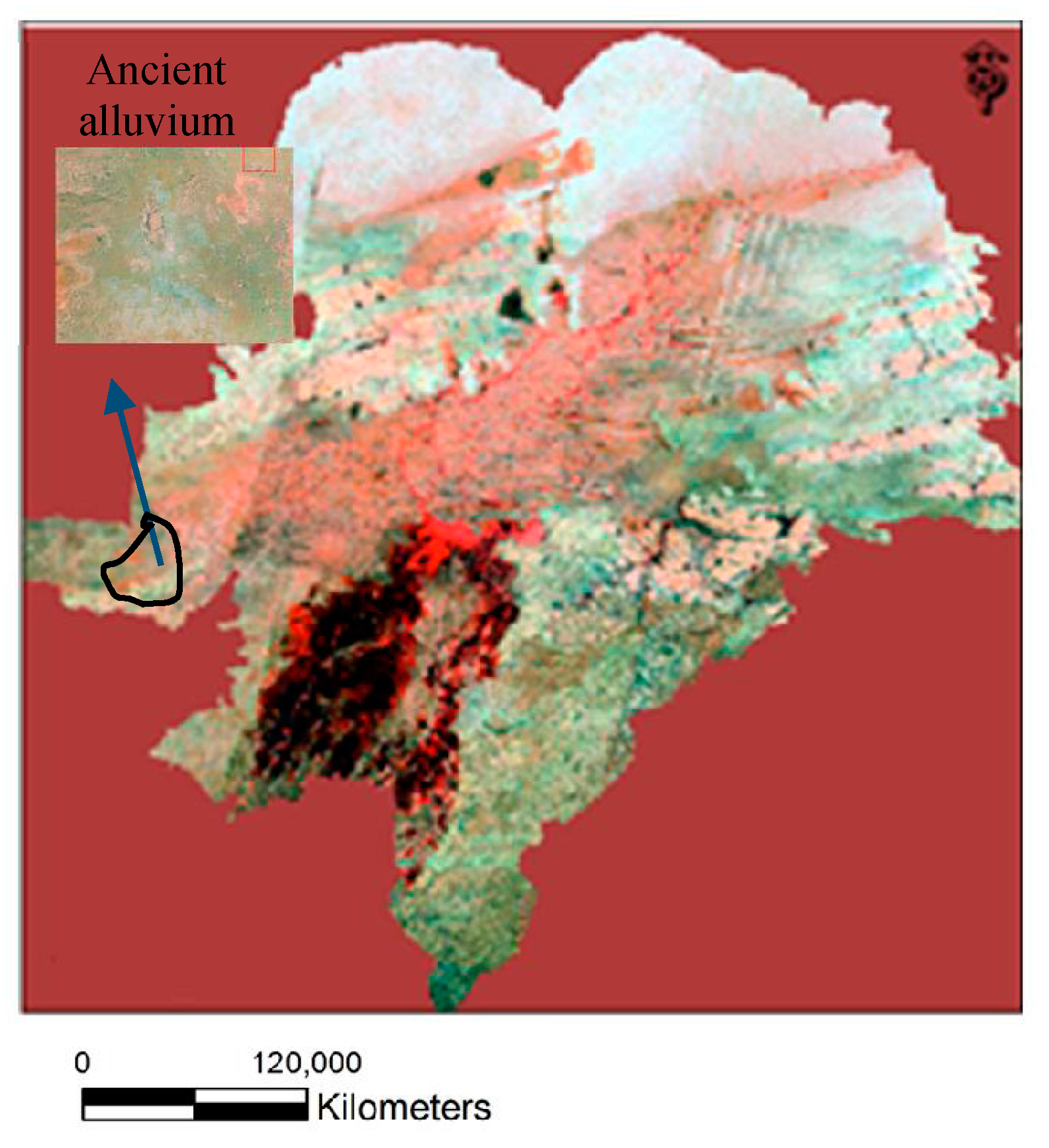
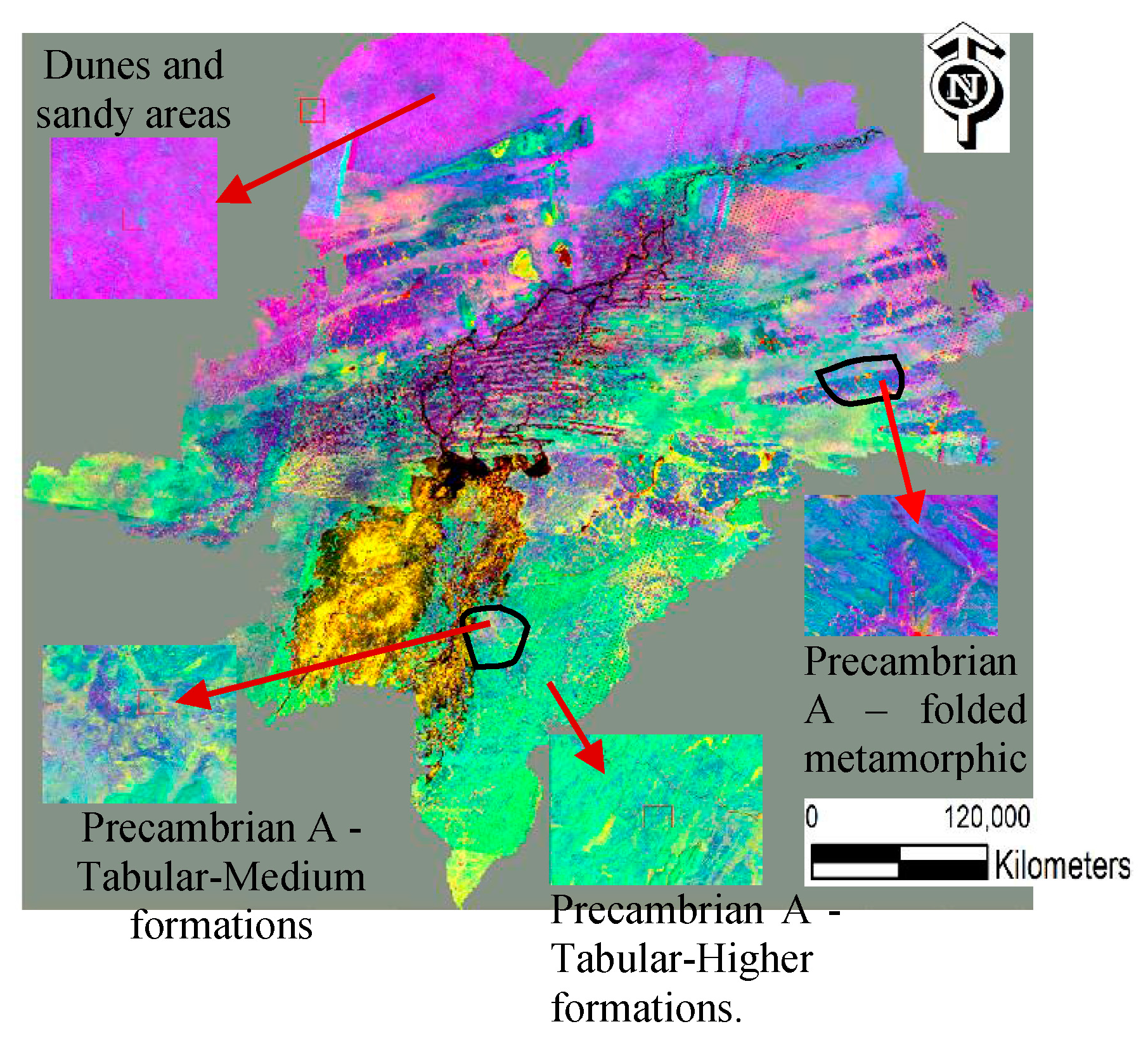
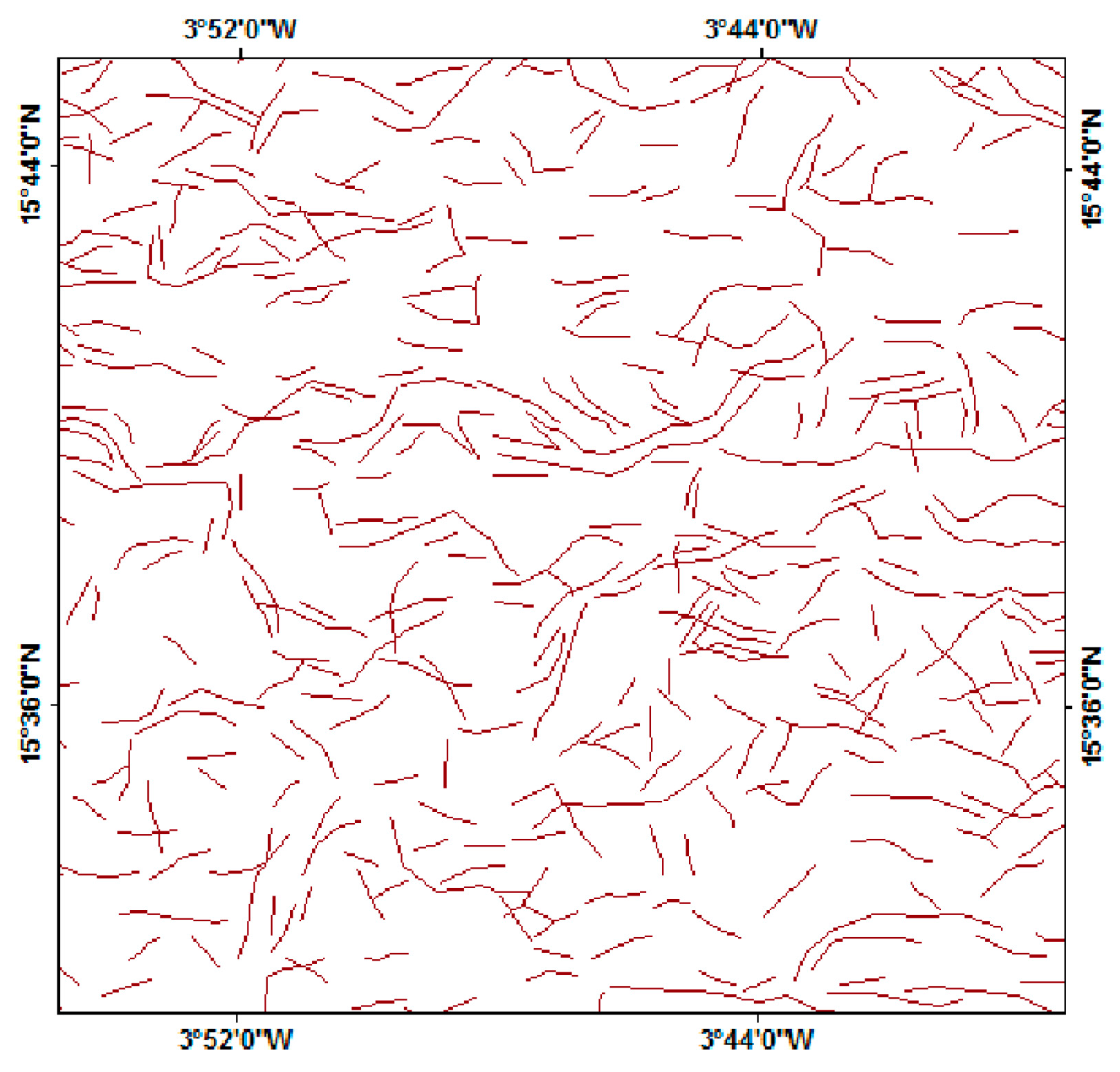
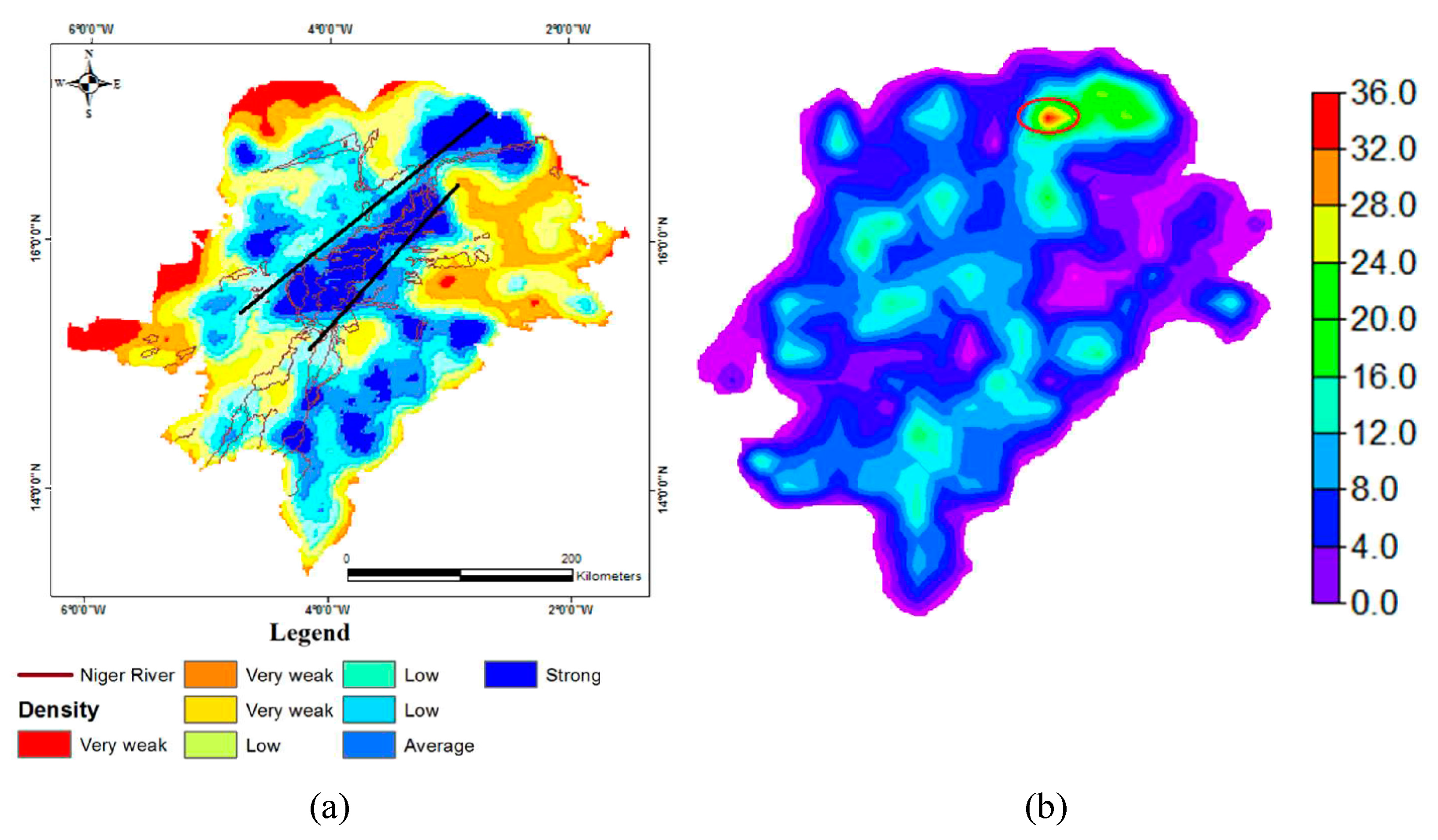

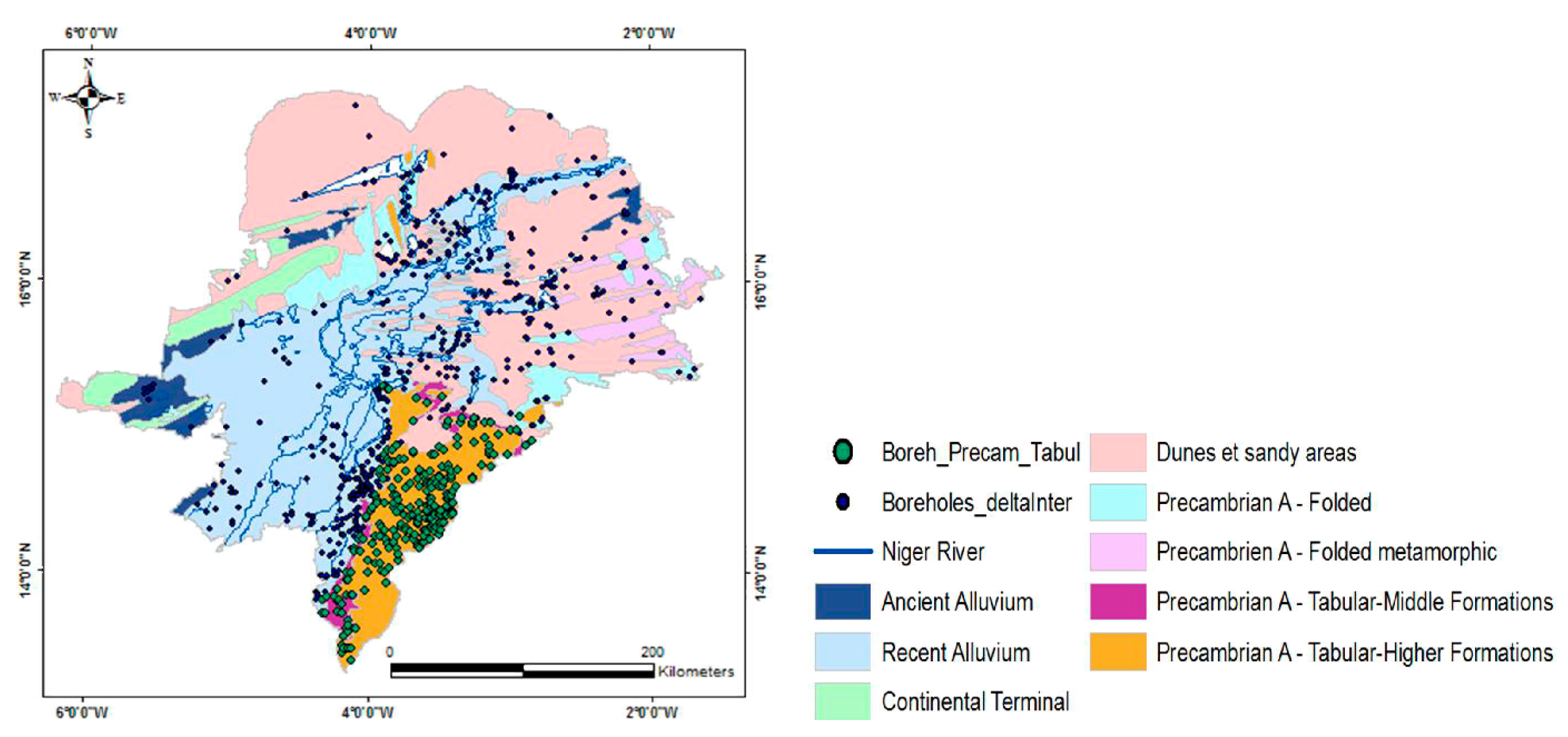

| Names | Parameters | Values | Units |
|---|---|---|---|
| FiRa | Filter Radius | 10 | Pixels |
| EGTh | Edge Gradient threshold | 60 | Pixels |
| CLTh | Curve length threshold | 30 | Pixels |
| LFETh | Line filter error threshold | 3 | Pixels |
| ADTh | Angular Difference threshold | 30 | degrees |
| LDTh | Linking distance threshold | 20 | Pixels |
| Types of Aquifers | Stratigraphic Stages | Code AQF | Lithology Dominant | Area (km2) | Percent % |
|---|---|---|---|---|---|
| Generalized aquifers | Continental terminal/quaternary | CTQ | Dunes and sandy, Clays Sandy | 54,746.7 | 41.5 |
| Continental terminal/Intercalary | CTI | sandy clays, laterite | 5,137.1 | 3.9 | |
| Cracked aquifers | Precambrian Tabular | PCT | Granule, schistose sandstone, sandstone of granules | 15,374.8 | 11.7 |
| Precambrian folded | PCF | metamorphic schist, calcareous, quartzites | 11,558.7 | 8.8 | |
| Superficial aquifers | Quaternary | QAT | Gravels, sandy, laterite | 45,069.3 | 34.2 |
© 2017 by the authors. Licensee MDPI, Basel, Switzerland. This article is an open access article distributed under the terms and conditions of the Creative Commons Attribution (CC BY) license (http://creativecommons.org/licenses/by/4.0/).
Share and Cite
Dembele, A.; Ye, X. Spatial Analysis of Linear Structures in the Exploration of Groundwater. ISPRS Int. J. Geo-Inf. 2017, 6, 335. https://doi.org/10.3390/ijgi6110335
Dembele A, Ye X. Spatial Analysis of Linear Structures in the Exploration of Groundwater. ISPRS International Journal of Geo-Information. 2017; 6(11):335. https://doi.org/10.3390/ijgi6110335
Chicago/Turabian StyleDembele, Abdramane, and Xiufen Ye. 2017. "Spatial Analysis of Linear Structures in the Exploration of Groundwater" ISPRS International Journal of Geo-Information 6, no. 11: 335. https://doi.org/10.3390/ijgi6110335
APA StyleDembele, A., & Ye, X. (2017). Spatial Analysis of Linear Structures in the Exploration of Groundwater. ISPRS International Journal of Geo-Information, 6(11), 335. https://doi.org/10.3390/ijgi6110335





